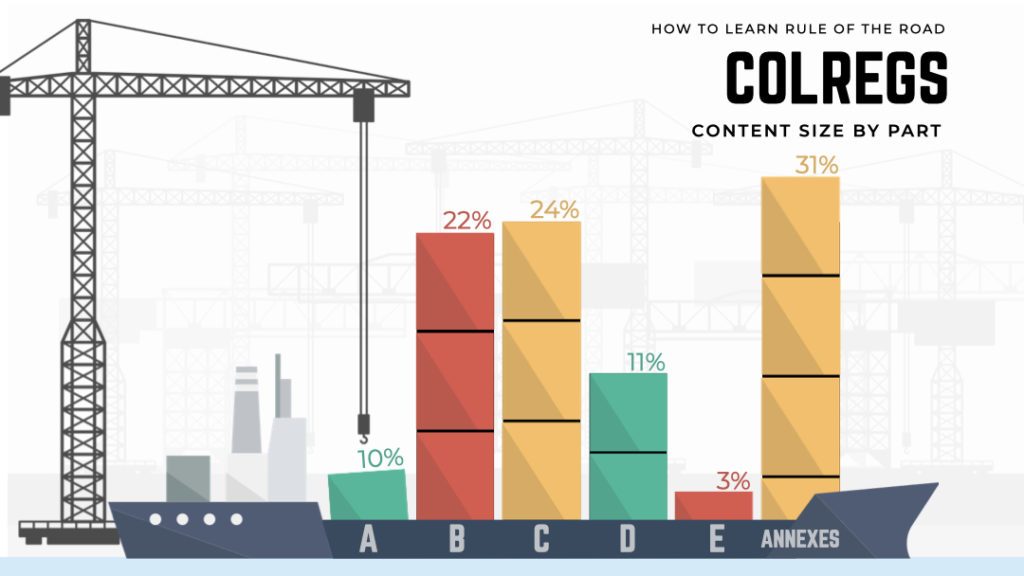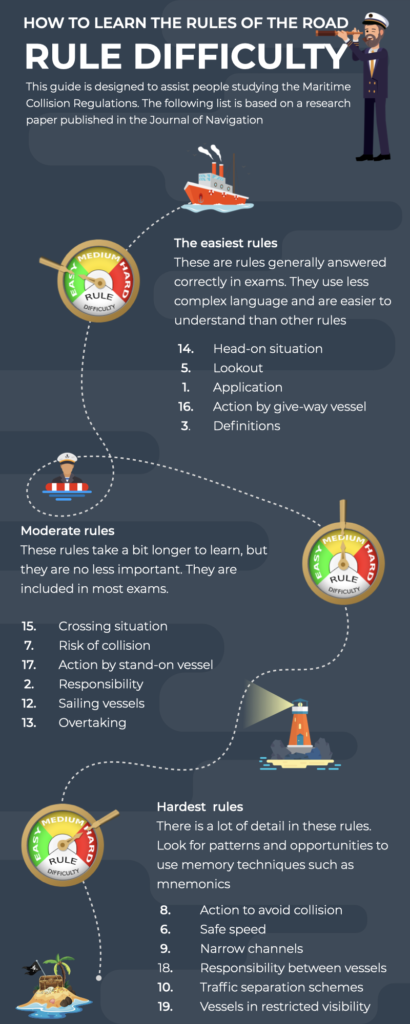Learning the nautical Rules of the Road can be confusing, there is lots to think about;
- Where should I start?
- Which rules should I learn?
- Do I need to know the rules verbatim or just understand their application?
- What resources do I need?
This article will help you navigate the do’s and don’t of learning the Rules of the Road. Based on decades of experience and the latest research we’ll show you where to start and how to make the most out of your study time.
Getting started
The full COLREGS or Rule of the Road text is pretty lengthy. At over 25,000 words it would take an average reader over 4 hours to read the whole book. The chances of remembering anything during this sort of reading marathon are very low.
So, when you first pick up a Rule of the Road book you shouldn’t try and read it from cover to cover. Take some time to get a bit of context and familiarise yourself with the layout. Formal collision regulations (COLREGS) have been around since 1840 and there have been several rewrites and amendments over the years, the most recent version is split into 5 parts and annexes.
- Part A General
- Part B Steering and Sailing Rules
- Part C Lights and Shapes
- Part D Sound and Lights Signals
- Part E Exemptions
- Annexes
Some of the parts have more content than others, here’s a diagram showing each part’s size in percentage.

This graph shows us that a lot of content is contained in the annexes. Ultimately this is good news, most rules of the road exams focus on Parts A-D and only the more advanced exams ask questions from small bits of the annexes. So when you first start to learn the Rules of the Road you should mainly focus on Parts A-D and only give the Annexes a quick glance.
Now that we have an area to focus on lets dive a bit deeper.
Which rules should I learn first?
Some of the rules are much easier to learn than others. The picture below shows rules 1-19 listed in order of difficulty, based on exam results.

Now that you have got a grasp of rules structure and difficulty you are ready to draft your “Passage Plan.†This is how you will navigate your Rule of the Road learning journey. Making a plan helps you to visualise what you are going to learn and how you are progressing. So get out a piece of paper and decided how many rules you are going to learn and in what order. It’s a good idea to have a target for the week, for example ‘this week I will learn rules 1,5 and 18’.
We recommend that you start with easy rules. This has a few advantages, it gives you a chance to get used to the language used in the rules before tackling the tricky ones and also gives you a chance to refine your learning methods.
Methods for learning rules of the road
Learning Style
Before you kick off your passage plan it is important to understand your preferred learning style. Students often try to learn the Rules of the Road using techniques recommended by friends or colleagues. This is like trying to run a marathon in someone else’s running shoes, you might get there in the end but it’s going to be painful. There are a bunch of free tests you can do online, try out this learning style assessment. Once you are confident you know your preferred learning style you are ready to move on to the next step.
Decide on your Rules of the Road learning techniques.
Once you have found out what type of learner you are it’s time to find some techniques that suit your style. There are several different ways to learn the Rules of the Road but not all methods will suit your learning style. Here are some techniques to consider depending on your preferred style.
- Visual – Firstly look for the pictures, whenever possible you should create an image for the rule or sentence you are trying to remember. There are lots of examples of this in our ‘How to remember’ video series. Once you have created some images try out the Memory palace technique. It’s likely that you will find flashcards very helpful, you can download our free flashcards here.
- Aural – Use a COLREGS audio recording, recite the rules into a recorder or Polly app. You could also talk about the rules with other students. Additionally, consider arranging a Rule of the Road debate or discussing a particular scenario with colleagues.
- Verbal – Try to identify uncommon words and sentence patterns, consider using mnemonics. The rules were written by different people, so each of them contains subtly different language. You will find it helpful to write or type out the rules. You could also use the Polly app to get quick feedback on which parts of the rule you are getting wrong.
- Physical – Bring the rules to life using models or physical objects. Generate a scenario that requires reference to the rule you are trying to learn. Display that scenario using models and playout the required actions, or walkthrough the manoeuvers in a physical space. Example Rule 12 head-on situation, act out which way you should turn. Think about how you could represent in the lights, shapes, and signals in a physical form. Additionally, you should print out and complete our Lights, shapes and signals worksheets. Try displaying the different sheets in memorable places around your workspace.
Should I learn the Rules of the Road verbatim?
Whether you choose to learn the rules verbatim somewhat depends on your ambition. A good understanding of the Rules of the Road will be sufficient for most cadets or trainees in the early part of their careers. However to have a complete understanding of the rules and an ability to apply them instinctively you will need to be able to recall a lot of the fine details. As your career and training progresses you will be expected to develop your knowledge, many maritime organisations will require you to learn at least some of the rules verbatim.
What resources do I need?
It normally takes students several months to learn the rules. So it is worth spending some time and money on resources. Therefore if you love stationary now is the time to treat yourself to some decent pens. You can find lots of free resources on our website as well as an app (Polly) designed to help you remember the rules and practice for exams.
And finally…
Learning the Rules of the Road is not an easy process, but there are some techniques you can use to make your studies more efficient and enjoyable. Familiarise yourself with the rules, make a “Passage Plan”, know your learning style and invest in some decent resources. Follow each of these steps and you’ll be ready for your next exam and the rest of your career.
